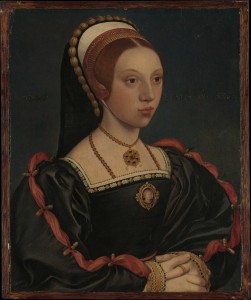
Lady Rochford (Jane Boleyn), who was accused of helping Catherine with her treachery, had been taken to the Tower the previous night, having been nursed back to health from “symptoms of madness”. She had been nursed at Russell House on the Strand, the London residence of Sir John Russell, Lord Admiral, and his wife Anne, under the supervision of the King’s own doctors.1
Chronicler Charles Wriothesley records Catherine’s move to the Tower:
“The 10th of February the Quene was had by water from Sion to the Tower of London, the Duke of Suffolke, the Lord Privie Seale, and the Lord Great Chamberlaine having the coveyance of her.”2
Eustace Chapuys, the imperial ambassador, also recorded Catherine’s journey:
“Some days after, that is to say on the afternoon of the 10th, the Queen after some difficulty and resistance was conducted to the Tower by the river. The Lord Privy Seal, with a number of privy councillors and a large retinue of servants, went first in a large oared barge; then came a small covered boat with the Queen and four ladies of her suite, besides four sailors to man the boat. Then followed the duke of Suffolk in a big and well-manned barge, with plenty of armed men inside. On their arrival at the Tower stairs the Lord Privy Seal and the duke of Suffolk landed first; then the Queen herself, dressed in black velvet, with the same honors and ceremonies as if she were still reigning.”3
So, Catherine was escorted by Charles Brandon, Duke of Suffolk; William Fitzwilliam, 1st Earl of Southampton and the Lord Privy Seal; and Robert Radcliffe, 1st Earl of Sussex and Lord Great Chamberlain.
A bill of attainder against Catherine Howard and Lady Jane Rochford was introduced into the House of Lords on 21st January 1542 and received royal assent on 11th February. According to this bill, the women were guilty of treason and could be punished without there being any need for a trial.4 Something else which received royal assent in the House of Lord on 11th February was an act “for due process to be had in high treason in cases of lunacy or madness”.5 This meant that “a person becoming insane after the supposed commission of treason, might be tried; or losing his rational faculties after attainder, might be executed”, so even if Lady Rochford didn’t recover her faculties she could still be executed.6 Henry VIII was determined to punish these women. The legislation regarding insane people and high treason was repealed in Mary I’s reign, by the Treason Act of 1554.7
Also on this day in history, 10th February 1567, the murder of Henry Stuart, Lord Darnley, husband of Mary, Queen of Scots. Click here to read more about his murder.
Notes and Sources
Image: Portrait of an unknown woman thought by some to be Catherine Howard, workshop of Hans Holbein the Younger, the Metropolitan Museum of Art, New York.
- Letters and Papers, Foreign and Domestic, Henry VIII, Volume XVI, 1401.
- Wriothesley, Charles (1875 edition) A chronicle of England during the reigns of the Tudors, from A.D. 1485 to 1559, Volume 1, Camden Society, p. 133.
- Calendar of State Papers, Spain, Volume 6 Part 1, 1538-1542, 232.
- LP xvii. 28 ii Acts printed in the Statutes at Large, but not entered on the Parliament Roll, C21.
- LP xvii. 28 xv c. 20, o.n. 33 of the year 37 Hen. VIII.
- ed. Wharton, Thomas I., Esq (1842) The Law Library, Volume 38, John S. Littell, p.230.
- The Treason Act 1554 (1 & 2 Ph & M c. 10), mentioned in “History of Insanity as a Defence to Crime in English Criminal Law” by Homer D. Crotty, in California Law Review, Volume 12, Issue 2, Article 3, January 1924, p. 111.